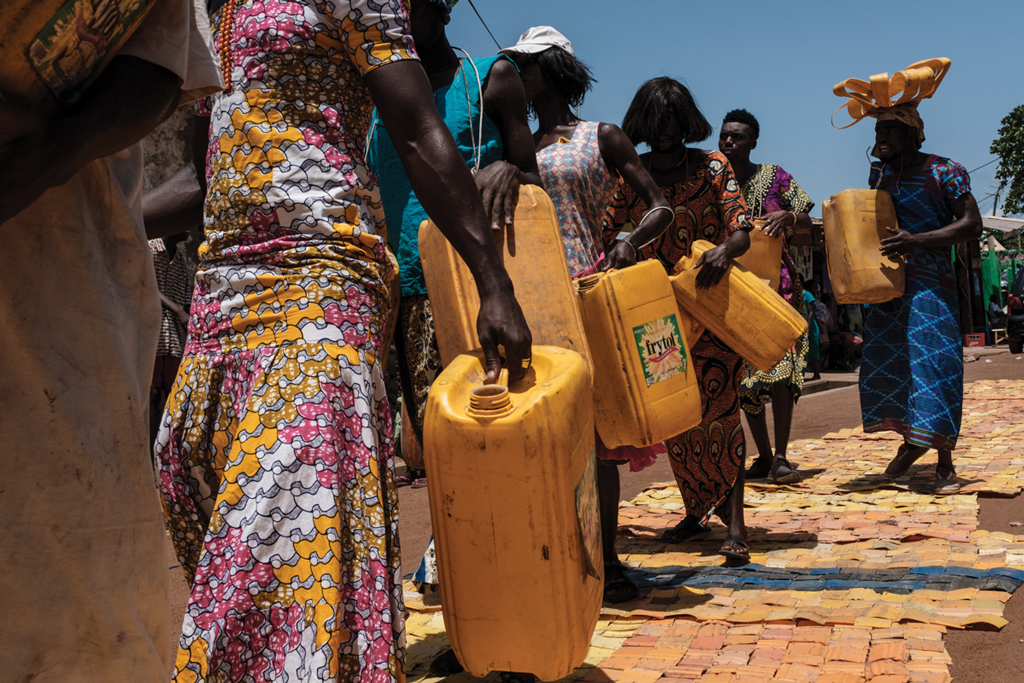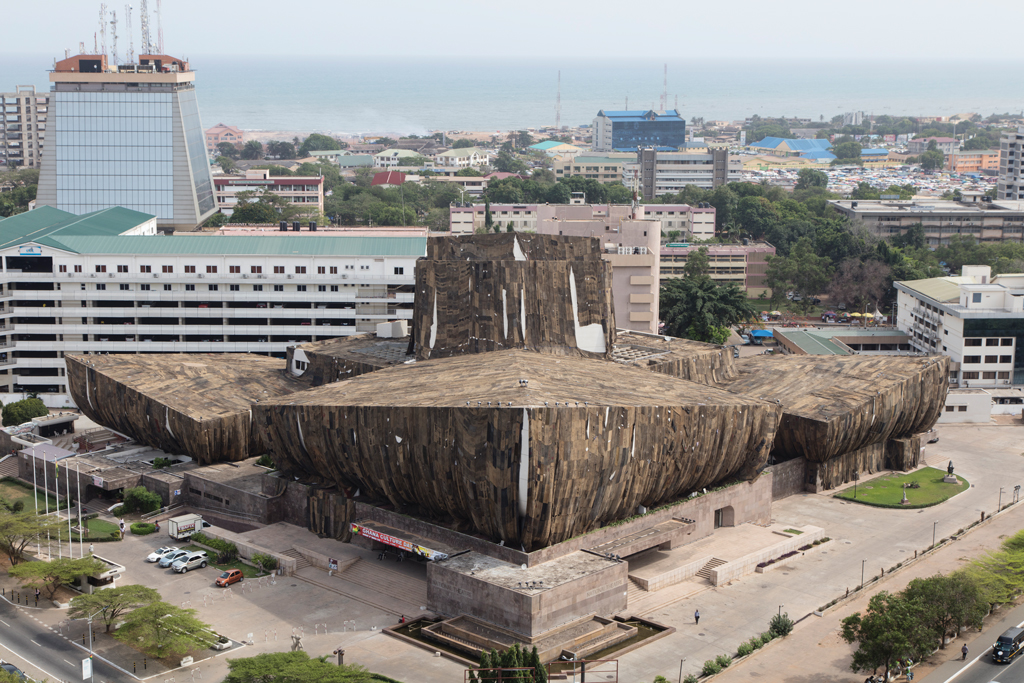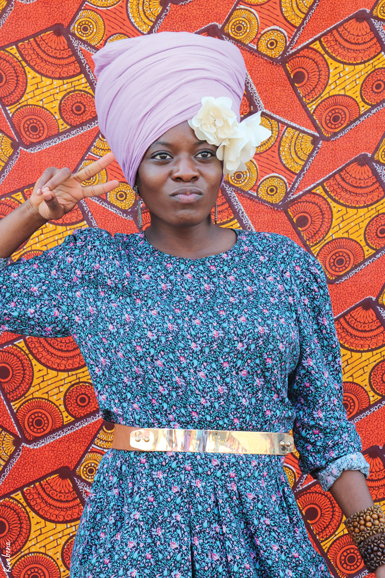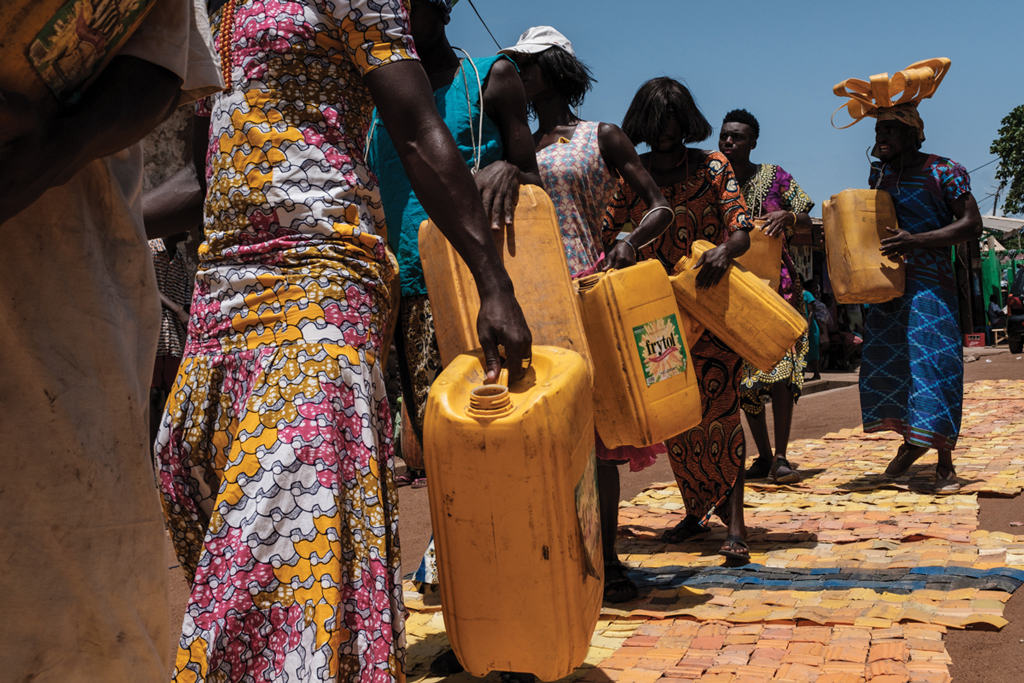[ad_1]

Scenes from the Labadi nighborhood of Ghana, where performers and locals participate in Serge Attukwei Clottey’s Afrogallonism piece.
FRANCIS KOKOROKO
This past April, a group of men wearing dresses and wigs, their lips painted bright red and pink, some in big hoop earrings, trudged through the streets of the Labadi neighborhood in Accra carrying large yellow plastic containers that had been stitched together. Called gallons in local parlance, the containers were from the nearby studio (and home) of artist Serge Attukwei Clottey, who uses them to make his art, which he calls “Afrogallonism.” Clottey had put one of his giant installations on temporary display in the area, hanging interlinked bits of the gallons over dilapidated buildings and using them to pave a bright yellow path. As the performers passed by, locals looked on. Children chased after them. Women cooking food on outdoor stoves paused to observe the spectacle. An hour or so later, the group, their gallons in tow, circled back to Clottey’s nearby studio where they all posed for photos.
“It makes people want to know what is going on,” Clottey said of what has become a monthly ritual. “This is how we get conversations going.” He posted an image of the installation on his Instagram with the caption “Follow the yellow brick road.”
Over the past ten years, the art scene in Ghana, and its capital, Accra, in particular, has grown considerably, and artists have increasingly been making work that engages communities and utilizes public space. Clottey, for instance, wants to provoke discussion around the gallons, which enter the country carrying oil. Locals repurpose them as water jugs, filling them at various water sources throughout the city and storing them in their houses. They are unhygienic and not biodegradable, and serve as a symbol of the problems the area has in accessing clean water. To bring this message home, Clottey has made it part of his practice to display his installations regularly in the neighborhood for community members to see prior to any local or international exhibition of the work.
Clottey has been doing these public interventions since 2012, but in recent years, he has noticed that his neighbors’ perceptions of his work has shifted. Where they were once at best bemused by his work (and at worst, disturbed), they have started to be interested in other possibilities for the plastic jugs. Could they be used to build a house? To create roads?
“At this point, artists are not afraid to explore or experiment with their art and the exhibition space,” said Adwoa Amoah, codirector of the Accra-based artist network Foundation of Contemporary Art Ghana (FCA) since 2007, adding that, for instance, “the ordinary person is now comfortable with seeing murals in the city, and many people commission artists to do murals, which we didn’t have before.”

Scenes from the Labadi nighborhood of Ghana, where performers and locals participate in Serge Attukwei Clottey’s Afrogallonism piece.
FRANCIS KOKOROKO
Clottey is one of many artists in the city who at some stage in their career were members of the FCA, founded in 2004 by the late Joe Nkrumah, an anthropologist and curator, and artist Virginia Ryan. Over the last ten years, FCA has further sought to broaden the mediums through which artists and audiences can interact, while providing support and mentorship for the wider creative community.
Ten years ago, “there were very few galleries and almost all the galleries that existed were commercial,” said Ato Annan, who has codirected the FCA with Amoah since 2011, adding that this is still the case. High-end hotels like the Golden Tulip and Novotel, now the Accra City Hotel, would host monthly exhibitions in their lobbies, and the Alliance Française, the British Council, and the Goethe-Institut put on shows. But homegrown spaces dedicated to fostering creativity were few and far between.
When the FCA began, in addition to providing a research library and internet access for artists, they started hosting events like artist talks and temporary exhibitions in the gardens of embassies and ambassadors’ residences. Annan and Amoah took things further—they wanted to “move ‘Art in the Garden’ into art and public spaces to get the artists to engage directly with the Ghanaian public or with communities,” as Annan put it.
“This was just purely intuitive,” Annan continued. “We hadn’t even thought critically about the implications of what we were doing, but we said, OK, look, for artists who were locked up in their studios painting or sculpting—get them out of their studios . . . There were very few artists who had socially engaged practices. So let’s move the artists into the community and let’s just get them [there] even if it means setting up studios and having the artists work in public spaces and inviting the community to work with them.”
In 2009 the FCA organized a series of artist installations and performances in communities around Ghana, starting in Jamestown, where artists drew murals on the walls of a local park as a way of rejuvenating the space. They moved on to do projects in Takoradi, Western Region; and Cape Coast, Central Region. The point was to draw from the spirit of each place. Accra’s history, for example, can be found in its residents, said Annan. “The individual narratives of this city are all unique to it,” he said, “and these are some of the things artists can develop a practice from.” Working in—and with—public spaces, Amoah added, inspires artists to think outside the box. “The outdoor space is malleable,” she said. “You can shape it to suit whatever ideas you’re thinking of.”
The use and reuse of space, depending on the user’s need, is familiar to many in Ghana, particularly in increasingly urbanized cities and towns where necessity encourages multiplicities. Kiosks that serve as vegetable stands during the day become drinking spots at night. Sidewalks become bend-down “boutiques” where customers rummage through piles of clothes and, with the city’s lack of infrastructure, waterways become rubbish dumps. Space for the sake of space becomes the preserve of the privileged.

A 2016 installation by Ibrahim Mahama at Accra’s Malam Dodoo National Theater.
COURTESY MALAM DODOO NATIONAL THEATER
There is an image that comes to mind when passing through Accra Central, the administrative center of the city, with the new, slick glass-and-steel buildings of its financial district. In 2016 artist Ibrahim Mahama staged a multisite intervention in Accra, blanketing—in a manner for which he is famous—the Malam Dodoo National Theater and a construction site close to the recently renamed Jubilee House, the official residence and office of the president, with jute sacking. From the rooftop of World Trade Center opposite, Mahama contemplated the installation, taking photographs of the darkened mound of sacks below. Over the course of the intervention from day to day, Mahama would note the shifting of the cloth panels.
What I see when I look at these photos is what is not captured in them: Makola, the city’s largest open-air market, a mile southwest of the National Theater. It is there that many of Mahama’s collaborators, who came to the capital from other parts of the country looking for work, live, often in tight quarters in meager conditions.
Another artist staging such interventions is Zohra Opoku, who festooned five billboards in various locations around the city with secondhand clothing between 2014 and 2015 for an initiative she called “Who Is Wearing My T-Shirt: The Billboard Project.” She left the clothing on each billboard for a month—the arrangement of dresses, T-shirts, overalls, and trousers billowing in the wind and looking like displays in the markets where they were sold—in an effort to draw attention to the proliferation of imported goods into Ghana at the expense of local industry. As part of the project, she held workshops with children from schools in the surrounding areas that encouraged them to question Western consumerism. Ironically, while Opoku was installing the clothes on the billboards, she was often asked why she wasn’t selling the clothes to make money. At two of the billboards, the clothes were inconspicuously removed.
Meanwhile, Bernard Akoi-Jackson has been using public space for performances, some of them as part of the Chale Wote Street Art Festival in Jamestown, an annual event organized by ACCRA [dot] ALT. Covered at different times in blue or gold paint, he paced slowly along High Street as though in meditation or a trance. The walk became a spectacle within a spectacle: While other performances and art-making activities went on, Akoi-Jackson’s quiet movement forced onlookers to slow down as he had. Some even joined in and formed a train behind or walked alongside him.
Akoi-Jackson rejects the idea that art should produce some kind of uninhabitable space around itself. “The tendency of art, and performance especially,” he said, “is to be a spectacle and take over the space and make the place almost sacred, so that nobody can simply pass by.”

An attendee at the 2013 Chale Wote Street Art Festival.
KWABENA AKUAMOAH-BOATENG, VIA FLICKR
On numerous occasions, Akoi-Jackson has been stopped on the street by people who recognize him from his Chale Wote performances. “It’s that shared solidarity of space where they, through their actions, tell you, ‘I recognize you, I see what you are doing,’ ” he said.
In Kumasi, Ghana’s second-largest city, a collective called blaxTARLINES Kumasi has also been challenging traditional exhibition formats, activating spaces like an old train shed, a car showroom, and a few times, the National Museum in Accra. Supported by the Department of Painting and Sculpture at the Kwame Nkrumah University of Science and Technology in Kumasi, the group consists of a vibrant community that includes artists and lecturers from the department as well as other artists and members of the public. Using nontraditional spaces to exhibit, blaxTARLINES transforms them with immersive art, creating a symbiotic relationship between the art and everyday life.
Artists creating and experimenting on their own terms—with varying degrees of criticality—also bring with them new spaces such as ANO and Gallery 1957, which have joined older galleries and art centers like Artist Alliance (established in 1993), Nubuke Foundation (2006), Berj Gallery (1996), and the Dei Centre (2009). Lately, numerous nonexhibiting venues have been surfacing through which artists engage their audiences in critical discussions about their work.
Photographer Eric Gyamfi’s images of moments in the lives of those who inhabit some of Ghana’s queer communities—where people live, work, and thrive—inserts them into contemporary discourse, as well as into the country’s collective future memory.
The places he photographs, where his “participants” live, are to him representative of “what the city does when the rest of the world is not watching. These are places that people within the city proclaim do not exist, for the most part—and experiences that the city would not acknowledge.”
Gyamfi is confident that he can change perceptions both in and outside Accra. “I look at my relationship [with Accra] as an exchange,” he said. “I know I have the power to affect the life of the city because I am inside it. The life of the city has a way of affecting me. I am aware of how I use myself, my body, and my work to affect the way the city is, or will be, read.”
In one of his photographs, a wall bears graffiti reading “Parents train your children against lesbians in this araa!!!” and “May Alah forgive them,” all seemingly by the same hand. Gyamfi’s lens is trained on a woman walking by, who pays the scrawls no mind.
The late Ghanaian poet and author Kojo Laing, in his 1986 novel Search Sweet Country, describes the spirit of Accra during the seventies, just over a decade after the country officially gained political independence from Britain. It reads, “[Accra is] the bird standing alive by the pot that should receive it, and hoping that, after being defeathered, it would triumphantly fly out before it was fried.”
This line describes an idle, and potentially doomed, Accra yet to take hold of its own destiny—which could extend to Ghana as a whole. Whether this perception has changed throughout the various strata of society here is debatable, but in the art space, at least, communities of people are shifting the country away from that proverbial pot.
A version of this story originally appeared in the Summer 2018 issue of ARTnews on page 82 under the title “The City as Canvas.”
[ad_2]
Source link

